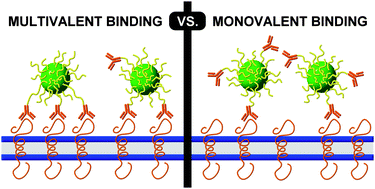Tumour cells are often associated with altered surface receptor profiles, and these changes can provide a basis for targeted delivery of anti-cancer agents. Functionalizing a colloidal drug delivery vehicle, such as a polymeric nanoparticle, with several targeting ligands has qualitatively been shown to increase the effective affinity of the nanoparticle for its target receptor over the affinity of the free ligand. However, whether this increase results from multiple simultaneous interactions per particle (multivalent binding) or increased configurations for single binding events per particle (monovalent binding) is unclear. A quantitative approach was required to distinguish between these possible mechanisms. In this study, human epidermal growth factor receptor 2 (HER2) overexpressing cancer cells (SKBR-3) were used as the target for anti-HER2 (trastuzumab, Herceptin™) immunonanoparticles. We varied the antibody conjugation density on the immunonanoparticles and measured their cellular binding by a flow cytometric immunoassay. Using this method, we were able to directly assay the targeted cells and quantify immunonanoparticle binding strength, allowing us to better understand whether immunonanoparticles were bound by monovalent or multivalent interactions. The binding data for each formulation were fitted to Langmuir isotherms, and based on the theory presented herein, it was concluded that the system studied behaved in a manner consistent with monovalent binding. Understanding this property of immunonanoparticle binding is useful in drug delivery applications, where manipulating the strength of such interactions is essential to controlling their targeting capacity on both tissue and cellular levels. The models developed here can be used to quantitatively predict binding strength for rational immunonanoparticle design.

You have access to this article
 Please wait while we load your content...
Something went wrong. Try again?
Please wait while we load your content...
Something went wrong. Try again?


 Please wait while we load your content...
Please wait while we load your content...